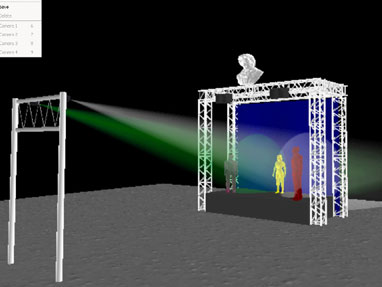Media leads this page, with videos at the top and pics lower down. If you really want to get deep, at the bottom of the page is technical info with links, pics, and vids showing how we make it all happen.
Videos
Here we have a few videos showing some of the work that goes into building the shows - just click a thumbnail to the right to watch one of the vids.
|
You need Flash player 10+ and JavaScript enabled to view this video.
|
Images
To see the slideshow controls, hover your mouse over the big pic. If you want to restrict the images to a certain show build (years 2006-07, 2008-09, 2010-11), click one of the buttons beneath the thumbnails.
|
|
|
|
|

|

|

|

|
Behind-The-Scenes Tech
Here's the skinny on how we run the shows.
LIGHTS:
For the first four years we used a great freeware lighting program called DMXControl. It allowed us - with the help of an Enttec USB-DMX dongle - to use a laptop PC to control dimmer packs. The dimmer packs are multi-channel power sources for our lights...give a channel a higher number from DMXControl and the light plugged into that channel gets brighter, and vice versa. DMX is the standardized language used to control all kinds of theatre equipment.
 DMXControl's Virtual Stage
DMXControl's Virtual Stage
In 2006 we rented two 6-channel DMX dimmer packs, by 2007 we owned four 4-channel packs. At this point we have 48 dimmer channels, half store bought, half homemade. We also have DMX controlled moving lights, foggers, color scrollers, relay packs and strobes. It gives our light designers some options.
For 2010 and 2011 our lighting designer Mike brought in a real light board for us to use, an ETC Expression. It's a little more sure-footed than our freeware lighting program, not to mention worlds easier to program.
ANIMATION:
Well of course this is really important and I probably should have started here! There's a program by Brookshire Software called Visual Show Automation, or VSA for short. When we first started doing these shows they had only one version of it, for $49 if I remember correctly - pretty cheap. Now there are three versions of the program with a wide range of capabilities, the cheapest runs $79. Still way worth the price in my opinion.
 VSA's programming window
VSA's programming window
The coolest thing about VSA, and the reason I bought it to start with, is the Wave Motion Analysis. It's for making a robot mouth servo look like it's really saying what a vocal track is saying. VSA analyzes an audio file of somebody speaking, and then automatically creates the motion programming for the servo. Genius! Watch our Proof of Concept video to see how well it works!
Oh, I suppose I should explain servos. All of our skeletons are homemade as far as the automation is concerned. We use (mostly) radio control servos on aluminum endo-skeletons to control their motion.
 One endo-skeleton design
One endo-skeleton design
I started out using an interface board by Scott Edwards Electronics called the Mini SSC 2 to drive the servos (controlled by VSA) but now I'm moving into using some other interface boards. The SSC 2 drives 8 servos, there are other boards now that are cheaper that drive 16. I shop online at Sparkfun for those.
HOMEBUILT CONTROL:
Last but not least is the electronic hardware we've built ourselves. My cousin David who programs for Google spent the first couple of years making a really tight piece of code that we use for running relays.
 David, madly programming
David, madly programming
We load the control box code into PIC microprocessors, the PIC16F690 for geeks who want to know, and it lets us turn relays on and off from VSA. The control box drives two different kinds of relay boxes that we make - either 12 volt DPDT relays for low voltage loads, or solid-state relays to control 120 volt AC loads. We have enough control boxes to control 75 different relays.
 Relay Control box
Relay Control box
We also use a PIC as well as a custom program written in Microsoft Visual Basic to program arm motion for our skeletons. David wrote the program, I build the hardware for a programming mini-skeleton. It has three potentiometers each on two arms, and as I listen to the show track I move the arms around how I want and the computer records all six axes at once. Then I import that information into VSA and I've got the majority of a skeleton's motion done.
 The Mini-Skeleton
The Mini-Skeleton

